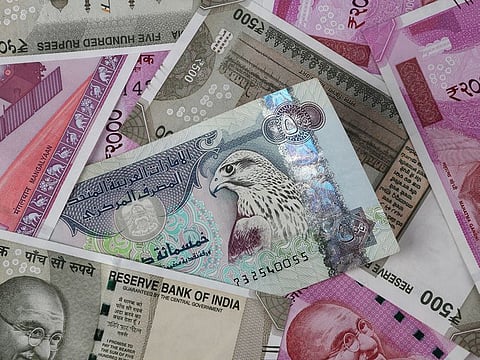Sending money to India from UAE? Rupee remains nears all-time low of 22.71 to dirham
Indian currency remains soft as dollar spikes and RBI leaves interest rates intact

Dubai: The Indian rupee is firming up - slightly - in morning trades after the country's central bank retained the status quo on interest rates for a seventh straight time. The currency had closed yesterday (April 4) at a year's low of 22.71 to the dirham (or 83.44 to the dollar) and is currently at 22.65.
"The rates are extremely favourable for Indian expats in the UAE and Gulf, especially as there is still remittances to be sent during Eid holidays next week," said Neelesh Gopalan, Senior FX analyst at a Dubai-based fintech. "Already, the UAE market had seen some heavy remittance volumes in rupee-dirham since late March, and the 22.71 levels set off another big outflow on April 4.)
The short-term trend is for the rupee to weaken further, especially with the dollar strength gaining some serious pace in recent days. Today's slight firming up has more to do with the Reserve Bank of India's actions in the FX markets to provide some support for the rupee.
There is no doubt the Indian rupee will have come under further pressure if the RBI doesn’t intervene.

April 4 was the second time this year that rupee had dropped to its lowest point of 22.71 to the dirham this year, after March 22.
Earlier today (April 5), the Reserve Bank of India kept interest rate a constant, as it was widely expected to do. This is the fourth successive time rates have been left intact, and according to market observers, the central will likely stay on the same track until the general elections are over and the new government assumes its position in early June. (Unless something quite dramatic breaks in the global or Indian economy between now and then.)
What NRIs should watch out for
The dollar has been gaining across a broad range of global currencies in recent days, much of which has to do with expectations that the US Federal Reserve will finally get cracking on interest rate cuts from June.
The rupee's short-term prospects will also be hedged by Indian forex reserves at all-time highs of $645.6 billion. But against that there is the threat of rising crude prices and what that means for India's import bills.
The decision to maintain status quo will keep the ongoing residential real estate sales momentum on course and unimpeded.

Indian stocks, meanwhile, took the RBI move to keep things the same - at 6.5 per cent base rate - in its stride, gaining 53 points by 12.30 UAE time.
The India economy continues to put in some serious growth - RBI forecasts 7 per cent for financial year 2025 - and with key sectors continue to make headway even in a rate-unchanged environment.
Anuj Puri, Chairman of Anarock, the real estate consultancy, namechecks the two obvious win-wins - the Indian economy ticking along and inflation getting reined. "The decision to maintain status quo will keep the ongoing residential real estate sales momentum on course and unimpeded," said Puri. "Aspiring homebuyers eyeing a purchase will proceed with confidence.
"Housing sales across the Top 7 cities have been phenomenal in the last few quarters, even though prices are rising steadily. Average residential prices across these cities have seen a significant jump in the last one year – ranging between 10-32 per cent in Q1-2024 compared to Q1-2023. Thus, the breather which RBI's unchanged repo rate will provide to home loan borrowers is apt and welcome."
Countdown to elections
Above everything looms the elections, stretching over multiple rounds and culminating in the installation of the government.
Bloomberg reported that RBI's Monetary Policy Committee voted five-to-one to keep the benchmark repurchase rate at 6.5 per cent on Friday. The six-member panel also decided to retain its relatively hawkish policy stance of 'withdrawal of accommodation'.
Hotter-than-usual temperatures across the country and strong economic expansion has complicated the timing of any rate easing, according to Bloomberg. Rising food prices have been the main driver of India's inflation, which remains well above the Reserve Bank of India's 4 per cent target. The central bank governor has said in the past it wouldn't consider easing unless inflation settles durably around its goal.
Governor Shaktikanta Das said the central bank 'remains resolute in its assessment to aligning inflation to its target.' "The last mile of disinflation is turning out to be challenging."
India's economy is estimated to have expanded 8 per cent or higher in the fiscal year ended in March, with officials predicting over 7 per cent growth in the current financial year.
Sign up for the Daily Briefing
Get the latest news and updates straight to your inbox



